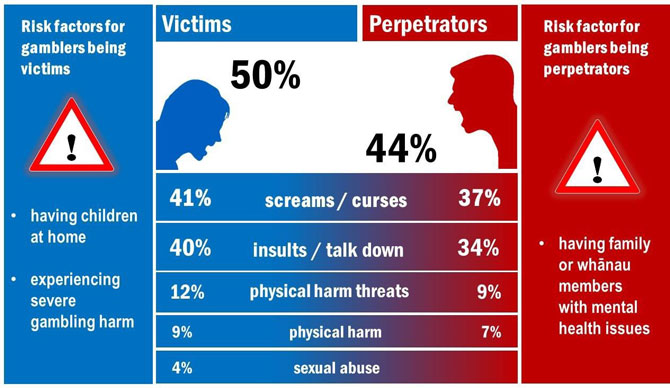Problem Gambling Statistics Nz
Produced by the Problem Gambling Foundation of New Zealand, P.O. Box 8021, Symonds Street, Auckland. Phone 368 1520 www.pfgnz.org.nz / www.problem-gambling.info Problem Gambling Foundation Hotline 0800 664 262 1. Statistics New Zealand. Gaming in New Zealand Key Statistics 2001 & Department of Internal Affairs. The Ministry of Health has responsibility for funding and co-ordinating problem gambling services. The results of the 2006/07 New Zealand Health Survey (Ministry of Health, 2009) indicate that 1.7 percent of the adult population were problem or moderate-risk gamblers. The Problem Gambling Foundation says Tararua needs to step up efforts to reduce the harm pokies are doing in the district and needs to introduce a 'sinking lid' policy on the number of gambling.
- Problem Gambling Statistics Nz Australia
- Problem Gambling Statistics College Students
- Problem Gambling Statistics Nz Population
- The Ministry of Health is releasing the Problem Gambling Intervention Services in New Zealand: 2007 Service-user statistics report. The report, released annually, presents and summarises the data.
- Gender and Problem Gambling Abbott and Volberg calculated that in 1999 there were 80,108 lifetime problem and pathological gamblers in New Zealand (2000:149 Table 20). This is 3% of the adult population. At the same time it was estimated that 2,629,522 had never had problems (see Table 4).

Nowadays gambling has become even more popular than decades ago, owing to the development of Internet technologies. There are millions of gamblers all over the world. Most of the players, who parlay responsibly and don’t cross their safe bankroll limits, will have a great time.
Unfortunately for some people, it’s not just harmless entertainment. Sometimes it can lead to serious issues in different aspects of life. This might happen when a person starts experiencing addiction problems (a player is not capable of controlling his/her gambling behavior).

Problem Gambling Prevalence Rate
Some countries show a higher prevalence rate than others, and it may be explained by cultural, economic, political, and legal factors. We’ll provide thorough information about gambling addiction in different parts of the world, based on recent research from 2016.
Australia
According to the statistics on problem gambling among the population, Australia shows quite high numbers. Approximately 0.5-1% (figures vary in different states) of citizens suffer from this addiction. This is so due to the changes in the betting industry due to digital technologies.
More people can now access betting entertainment via different online services, therefore the cases of unhealthy gambling have increased greatly. Each year Australians spend almost $1.5 billion on online wagering. Moreover, due to the high rate of illegal (in AU) sites, people are losing up to $0.5 billion to overseas companies.
That’s why Australia does everything to prevent unauthorized companies from entering their inner gaming market. According to the Gambling act 2001, with the recent amendment (2016), it is prohibited for foreign casino operators to provide their service there unless they are not licensed in AU.
Such strict rules also serve for decreasing the rate of dangerous betting habits.
Canada
Interestingly, Canada is among the countries with the highest percentage of gambling addicted citizens. Imagine that ¼ of all CA residents (or their friends/relatives) have suffered from some sort of bad consequences (job loss, depression, marriage problems and etc.) owing to their dependence.
And more than 80% of respondents have participated in lotteries during the past year.
It is a serious problem that affects millions of Canadians, although only half of those surveyed agreed that gambling can be dangerous.
New Zealand

Problem Gambling Statistics Nz Australia
New Zealand has the least number of problem gamblers according to the study by Business and Economic Research. It states that only a few citizens are liable to excessive betting behavior. Most of the casino clients in NZ are well aware of possible hazards, and know when it’s better to stop playing.
Norway
Despite the fact that there is government regulation of gambling activities, which provides various measures to decrease addiction problems among citizens, Norway is far away from the minimum rate of dependent people. Approximately 0.7% (more than in Denmark and UK) of the population in this country is grappling with the problem.
UK
Addiction drains a lot of money (about 1.2 billion pounds per year in the UK). Therefore, the government should pay special attention to this issue. According to various scientific sources, the cost also comprises special institutions service (mental health clinics), homelessness and police involvement.
The percentage of people who suffer from the bad influences of gambling varies from 0.6 to 1.1% of the total adult population. Diverse age groups show different liabilities to betting activities, which results in such data as 0.7% (for 25-34-year-olds), and 0.8% (for 18-24-year-olds). Moreover, the research also shows that unemployed, homeless, and people of color tend to be in the risk zone more often than others.
Problem Gambling Statistics College Students
USA

The USA is in the top list of countries, where a huge part of the population (2.6% or almost 10 million people) has an addiction problem because of gambling. These activities are represented in every state (even where they are restricted).
Of course, not all players have serious dependences, some just like to have some fun and feel a little risk, while others learn to gamble on a professional level, which helps to avoid big losses.
Unfortunately for other types of people, such an entertainment can lead to an illness, that should be treated (due to the high similarity with drug and alcohol addiction).
Overall, compulsive betting behavior costs about 6 billion dollars per year for U.S. economics.
Problem Gambling Statistics Nz Population
Distribution of Problem Players
Problem players have a different prevalence and it depends greatly on age and gender. These points are well-documented in the following paragraphs.
By Age
People are divided into age groups such as:
• 16-24 year olds – who show the most susceptibility (1.4%)
• 25-34 – tend to gamble less than their younger and older mates (0.8%)
• 35-44 – are also at a higher risk (1.1%)
• 45-55 and older – only 0.3% or less.
By Gender
The sharpest contrast we see is in the statistics that differentiate people by gender:
• Men – 1.2%
• Women – 0.1%.
Statistics of Device Usage
To understand the subject better, we will also provide statistics, which shows what devices are used mostly by problem gamblers:
• Laptops – 55%
• PCs – 34%
• Mobile phones/tablets – 29%/21%
It’s interesting to note, that mobile phones are used more commonly by 18-44-year-olds, while PCs are more popular among older people.